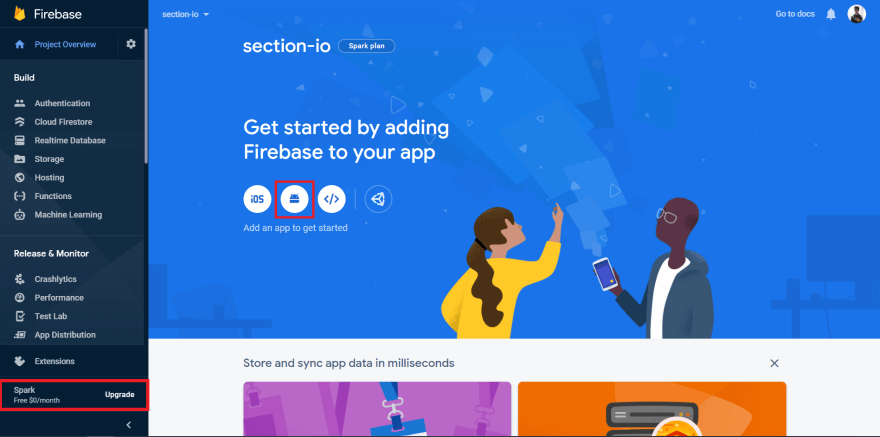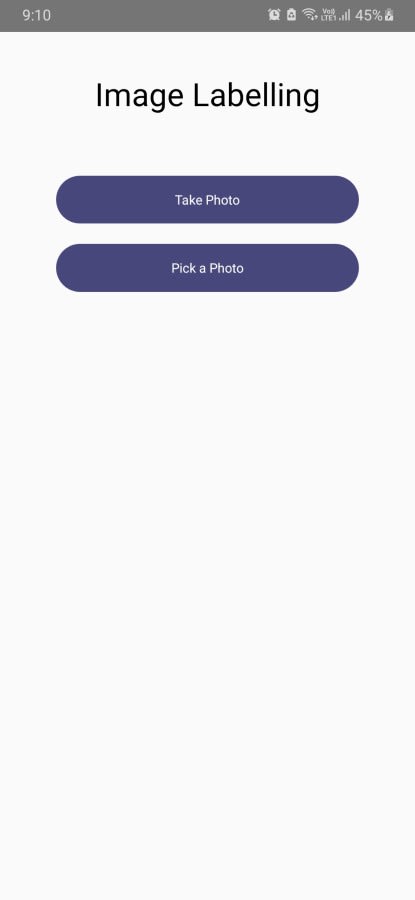Image labeling gives you insight into the content of images. In this tutorial, we will be building a Non-Expo React Native application to label the image provided using the machine learning kit from Firebase.
Firebase
Firebase is a platform developed by Google for creating mobile and web applications. It was originally an independent company founded in 2011. In 2014, Google acquired the platform and it is now their flagship offering for app development.
Firebase's ML kit is a mobile SDK that brings Google's machine learning expertise to Android and iOS apps. There's no need to have a deep knowledge of neural networks or model optimization to get started with the ML kit.
On the other hand, if you are an experienced ML developer, it also provides APIs that help you use custom TensorFlow Lite models in your mobile apps.
Prerequisites
To proceed with this tutorial:
You will need a basic knowledge of React & React Native.
You will need a Firebase project with the Blaze plan enabled to access the Cloud Vision APIs.
Overview
We'll be going through these steps in this article:
- Development environment.
- Installing dependencies.
- Setting up the Firebase project.
- Setting up Cloud Vision API.
- Building the UI.
- Adding media picker.
- Labeling the image using Firebase ML.
- Additional configurations.
- Recap.
You can take a look at the final code in this GitHub Repository.
Development environment
IMPORTANT - We will not be using Expo in our project.
You can follow this documentation to set up the environment and create a new React app.
Make sure you're following the React Native CLI Quickstart, not the Expo CLI Quickstart.
Installing dependencies
You can install these packages in advance or while going through the article.
"@react-native-firebase/app": "^10.4.0",
"@react-native-firebase/ml": "^10.4.0",
"react": "16.13.1",
"react-native": "0.63.4",
"react-native-image-picker": "^3.1.3"
To install a dependency, run:
npm i --save <package-name>
After installing the packages, for iOS, go into your ios/ directory, and run:
pod install
IMPORTANT FOR ANDROID
As you add more native dependencies to your project, it may bump you over the 64k method limit on the Android build system. Once you reach this limit, you will start to see the following error while attempting to build your Android application.
Execution failed for task ':app:mergeDexDebug'.Use this documentation to enable multidexing.
To learn more about multidex, view the official Android documentation.
Setting up the Firebase project
Head to the Firebase console and sign in to your account.
Create a new project.
Once you create a new project, you'll see the dashboard. Upgrade you project to the Blaze plan.
Now, click on the Android icon to add an Android app to the Firebase project.
You will need the package name of the application to register application. You can find the package name in the AndroidManifest.xml that is located in android/app/src/main/.
Once you enter the package name and proceed to the next step, you can download the google-services.json file. You should place this file in the android/app directory.
After adding the file, proceed to the next step. It will ask you to add some configurations to the build.gradle files.
First, add the google-services plugin as a dependency inside of your android/build.gradle file:
buildscript {
dependencies {
// ... other dependencies
classpath 'com.google.gms:google-services:4.3.3'
}
}
Then, execute the plugin by adding the following to your android/app/build.gradle file:
apply plugin: 'com.android.application'
apply plugin: 'com.google.gms.google-services'
You need to perform some additional steps to configure Firebase for iOS. Follow this documentation to set it up.
We should install the @react-native-firebase/app package in our app to complete the set up for Firebase.
npm install @react-native-firebase/app
Setting up Cloud Vision API
The Cloud Vision API allows developers to integrate vision detection features within applications like face and landmark detection, image labeling, optical character recognition (OCR), and tagging of explicit content.
The ML Kit uses the Cloud Vision API to label the images.
Head to Google Cloud Console and select the Google project that you are working on. Go to the API & Services tab.
In the API & Service tab, head to the Libraries section.
Search for Cloud Vision API.
Once you open the API page, click on the Enable button.
Once you've enabled the API, you'll see the Cloud Vision API Overview page.
With this, you have set up the Cloud Vision API for your Firebase project. This will enable us to use the ML Kit for labeling the images.
Building the UI
We'll be writing all of our code in the App.js file.
Let's start by adding 2 buttons to the screen to take a photo and pick a photo.
import { StyleSheet, Text, ScrollView, View, TouchableOpacity } from 'react-native';
export default function App() {
return (
<ScrollView contentContainerStyle={styles.screen}>
<Text style={styles.title}>Image Labeling</Text>
<View>
<TouchableOpacity style={styles.button}>
<Text style={styles.buttonText}>Take Photo</Text>
</TouchableOpacity>
<TouchableOpacity style={styles.button}>
<Text style={styles.buttonText}>Pick a Photo</Text>
</TouchableOpacity>
</View>
</ScrollView>
);
}
Styles:
const styles = StyleSheet.create({
screen: {
flex: 1,
alignItems: 'center',
},
title: {
fontSize: 35,
marginVertical: 40,
},
button: {
backgroundColor: '#47477b',
color: '#fff',
justifyContent: 'center',
alignItems: 'center',
paddingVertical: 15,
paddingHorizontal: 40,
borderRadius: 50,
marginTop: 20,
},
buttonText: {
color: '#fff',
},
});
Adding media picker
Let's install the react-native-image-picker to add these functionalities.
npm install react-native-image-picker
The minimum target SDK for the React Native Image Picker is 21. If your project targets an SDK below 21, bump up the minSDK target in
android/build.gradle.
After the package is installed, import the launchCamera and launchImageLibrary functions from the package.
import { launchCamera, launchImageLibrary } from 'react-native-image-picker';
Both functions accept 2 arguments. The first argument is the options for the camera or the gallery, and the second argument is a callback function. This callback function is called when the user picks an image or cancels the operation.
Check out the API Reference for more details about these functions.
Now let's add 2 functions, one for each button.
const onTakePhoto = () => launchCamera({ mediaType: 'image' }, onImageSelect);
const onSelectImagePress = () => launchImageLibrary({ mediaType: 'image' }, onImageSelect);
Let's create a function called onImageSelect. This is the callback function that we are passing to the launchCamera and the launchImageLibrary functions. We will get the details of the image that the user picked in this callback function.
We should only start the image labeling when the user doesn't cancel the media picker. If the user cancels the operation, the picker will send a didCancel property in the response object.
const onImageSelect = async (media) => {
if (!media.didCancel) {
// Image Labeling Process
}
};
You can learn more about the response object that we get from the launchCamera and the launchImageLibrary functions here.
Now, pass these functions to the onPress prop of the TouchableOpacity for the respective buttons.
<View>
<TouchableOpacity style={styles.button} onPress={onTakePhoto}>
<Text style={styles.buttonText}>Take Photo</Text>
</TouchableOpacity>
<TouchableOpacity style={styles.button} onPress={onSelectImagePress}>
<Text style={styles.buttonText}>Pick a Photo</Text>
</TouchableOpacity>
<View>
Let's create a state to display the selected image on the UI.
import { useState } from 'react';
const [image, setImage] = useState();
Now, let's add an Image component below the buttons to display the selected image.
<View>
<TouchableOpacity style={styles.button} onPress={onTakePhoto}>
<Text style={styles.buttonText}>Take Photo</Text>
</TouchableOpacity>
<TouchableOpacity style={styles.button} onPress={onSelectImagePress}>
<Text style={styles.buttonText}>Pick a Photo</Text>
</TouchableOpacity>
<Image source={{ uri: image }} style={styles.image} />
</View>
Styles for the Image:
image: {
height: 300,
width: 300,
marginTop: 20,
borderRadius: 10,
},
If the user did not cancel the operation, we should set the image state with the URI of the selected image using the onImageSelect function.
const onImageSelect = async (media) => {
if (!media.didCancel) {
setImage(media.uri);
}
};
Label the image using Firebase ML
Let's install the package for Firebase ML.
npm install @react-native-firebase/ml
Once the package is installed, let's import the package.
import ml from '@react-native-firebase/ml';
We should use the cloudImageLabelerProcessImage method in the ml package to process the image and label the image.
We will pass the URI of the selected image to this function.
const labels = await ml().cloudImageLabelerProcessImage(media.uri);
The function will process the image and return the list of labels along with the confidence the Machine Learning service has in that label.
Let's set up a state to store the results and render them in the UI. Since the result will be an array of labels, let's set the initial state to an empty array.
const [labels, setLabels] = useState([]);
Let's set the state to the response of the cloudImageLabelerProcessImage function.
const onImageSelect = async (media) => {
if (!media.didCancel) {
setImage(media.uri);
const label = await ml().cloudImageLabelerProcessImage(media.uri);
setLabels(label);
}
};
We'll use this state to render the details in the UI.
{labels.map((item, i) => (
<View style={{ marginTop: 20, width: 300 }} key={i}>
<Text>Label: {item.text}</Text>
<Text>Confidence: {item.confidence}</Text>
</View>
))}
Additional configurations
The cloudImageLabelerProcessImage method accepts an optional configuration object.
confidenceThreshold: Sets confidence threshold in the range of [0.0 - 1.0] of detected labels. Only labels detected with confidence higher than this threshold are returned.
apiKeyOverride: This is the API key to use for the ML API. If not set, the default API key from
firebase.app()will be used.enforceCertFingerprintMatch: Only allow registered application instances with matching certificate fingerprints to use ML API.
Example:
await ml().cloudImageLabelerProcessImage(imagePath, {
confidenceThreshold: 0.8, // undefined | number
apiKeyOverride: "<-- API KEY -->", undefined | string,
enforceCertFingerprintMatch: true, // undefined | false | true,
});
Let's Recap
We set up our development environment and created a React Native app.
We created a Firebase project.
We set up the Cloud Vision API to use the image labeler in the Firebase ML Kit.
We built a simple UI for the app.
We added the
react-native-image-pickerpackage to pick images using the gallery or capture images using the camera.We installed the Firebase ML package.
We used the
cloudImageLabelerProcessImagemethod in themlpackage to label the image.We displayed the results in the UI.
We learned about additional configurations that we can pass to the
cloudImageLabelerProcessImagefunction.
Congratulations, 🥳 You did it.
Thanks for Reading!





















Top comments (0)